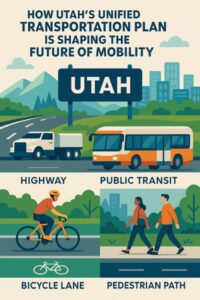
How do you plan transportation for a state expected to grow by over 2 million people in the next few decades? In Utah, the answer is a Unified Transportation Plan—a coordinated, statewide effort that brings together agencies, cities, and communities to shape how people and goods move for the next 30 years.
Unlike many states that manage transportation in silos, Utah takes a comprehensive, forward-looking approach that balances growth, safety, and sustainability. Let’s take a look at what makes Utah’s plan unique, how it’s already transforming infrastructure, and why it’s gaining attention as a national model.
What Is Utah’s Unified Transportation Plan?
Utah’s Unified Transportation Plan (UTP) is a comprehensive, statewide blueprint that outlines transportation investments and priorities for the next 30 years. What makes it stand out is its collaborative nature—bringing together the Utah Department of Transportation (UDOT), Utah Transit Authority (UTA), metropolitan planning organizations, and local governments under one strategy. The plan is updated every four years to ensure that it stays aligned with economic shifts, technological advancements, and population trends.
Unlike piecemeal transportation planning seen in other states, the UTP takes an integrated approach, covering highways, transit, bike lanes, pedestrian routes, and freight corridors all in one document. This helps eliminate redundancy, streamline budgeting, and focus on solutions that work across the board. It’s not just a transportation wish list—it’s a working plan grounded in data, public input, and clear funding pathways.
Why It’s Unique Compared to Other States
Most states approach transportation planning through separate agencies that often work independently of one another. Utah took a different route. By aligning agencies and municipalities through one shared vision, the UTP creates a more efficient process and allows for better coordination of resources and infrastructure. It ensures that when one project moves forward—like expanding a highway—complementary upgrades to transit or pedestrian systems are already part of the plan.
Another standout feature is Utah’s use of scenario-based forecasting. The plan doesn’t just project a single future—it models different economic and population growth outcomes to help decision-makers adapt to changing conditions. This approach reduces risk, improves accountability, and supports infrastructure that remains useful even if conditions shift. It’s a flexible strategy in a world where flexibility is increasingly necessary.
What the Plan Prioritizes
The UTP focuses on making transportation more accessible and efficient for everyone. Reducing congestion, improving commute times, and ensuring rural communities aren’t left behind are key goals. Investments are prioritized based on regional growth, public input, and return on investment—so the projects that serve the most people and improve quality of life are moved to the top of the list.
There’s also a strong push for sustainability. The plan outlines expansions in public transit, encourages carpooling, and supports cleaner transportation options like electric buses and EV charging infrastructure. Equity is another major theme—many of the plan’s strategies focus on making sure underserved communities have reliable access to jobs, schools, and healthcare via safe and affordable transit options.
A Safer Future by Design
Utah’s transportation plan places a strong emphasis on safety, making it a core design principle rather than an afterthought. Guided by Vision Zero principles, the UTP aims to reduce traffic fatalities and serious injuries to zero through smarter design, enforcement, and public education.
Road upgrades increasingly include roundabouts, median barriers, and protected left-turn lanes—features proven to reduce crash severity and frequency. For Utah’s vital trucking industry, these improvements also mean safer freight corridors and better flow along high-traffic routes like I-15 and I-80.
The state also invests heavily in pedestrian and cyclist safety. From safer crosswalks to protected bike lanes, these changes help prevent accidents before they happen. Data-driven crash analysis allows the state to identify high-risk areas, including those heavily used by commercial trucks, and prioritize improvements accordingly.
Still, when serious collisions do occur, especially those involving large vehicles, victims often turn to a Utah truck accident lawyer to help navigate the legal and financial aftermath. Programs like UDOT’s “Zero Fatalities” initiative combine infrastructure with behavioral education to promote a culture of safe travel across all modes, from foot traffic to freight transport.
Real-World Projects and Results
Several major projects already reflect the Unified Transportation Plan in action. The I-15 corridor, one of the state’s most heavily used roadways, has seen continuous upgrades, including smart traffic management systems that use sensors and real-time data to ease congestion. The FrontRunner commuter rail system, which connects cities along the Wasatch Front, is slated for major improvements to increase frequency and reliability.
Utah is also investing in active transportation infrastructure, building hundreds of miles of bike lanes, multi-use paths, and safer pedestrian routes. The UTA has expanded its electric bus fleet, supporting both clean air goals and fuel efficiency. These investments show the UTP isn’t just a vision—it’s producing visible, measurable results across urban and rural communities alike.
Challenges Ahead
Despite its forward-thinking design, the UTP faces real challenges. One of the biggest is funding. Inflation and fluctuating federal infrastructure allocations make it difficult to secure long-term budgets. As construction costs rise, even well-planned projects can stall or be scaled back without steady investment. State and local leaders have to consistently advocate for both public and private funding sources to stay on track.
Balancing the needs of fast-growing urban areas with more sparsely populated rural regions is another hurdle. What works in Salt Lake City might not be a priority for communities in southern Utah. The UTP tries to account for this with region-specific input and adaptable priorities, but ensuring equity across such a diverse state remains complex. Rapid technological change—like autonomous vehicles and emerging mobility platforms—requires constant updates to long-term planning assumptions.
Conclusion
What does it take for a state to stay ahead of rapid growth, technological change, and evolving transportation needs? Utah’s Unified Transportation Plan offers a clear answer: long-term, coordinated planning that connects roads, transit, and communities under a shared vision.
By focusing on integration, safety, sustainability, and adaptability, Utah isn’t just keeping up—it’s setting an example. As other states grapple with fragmented systems and short-term fixes, Utah’s model shows how future-ready infrastructure starts with unified thinking today.

